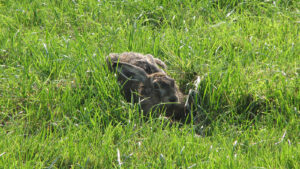Reappearance of tularemia in the central Netherlands
In October 2016 tularemia re-surfaced in hares (Lepus europaeus) in the Kromme Rijngebied (province of Utrecht) and the Vijfheerenlanden region in the neighbouring province of Zuid-Holland. Evidence of the disease was found in hares submitted to the Dutch Wildlife Health Centre for postmortem investigations and the bacteria was subsequently detected by further testing at Wageningen Bioveterinary Research Lelystad (the former Central Veterinary Institute, CVI). Hunters and people working or taking recreation in the countryside should remain alert for this disease.
Hares
Hares suffering from tularemia are markedly weak and apathetic. They may have a wobbly gait and tend to lose their flight reflex meaning they can be caught easily. These symptoms are common to many diseases and tularemia can therefore not be diagnosed based only on the presence of these signs. During the 2015 outbreak in the northerly povince of Friesland observers reported that hares appeared to be drunk.
People
In people, tularemia typically causes ulceration or severe inflammation of multiple lymph nodes. People can catch the disease from infected animals for example through direct contact or indirectly via insect and tick bites or by eating under-cooked meat from infected animals. There is more information about tularemia in people available at the website of the Centers for Disease Control and Prevention.
Preventative measures
Hunters and people working or taking recreation in the countryside are most at risk of infection with the bacteria that causes tularemia. It is therefore important to take certain preventative measures:
- Use insect-repellent when temperatures are warm enough for midges and/ or ticks and wear suitable insect-proof clothing
- Disposable gloves should always be worn when handling animal carcasses and discarded appropriately after use
- Wounds should be thoroughly disinfected and bandaged and existing wounds should be covered.
- Hands should be washed with soap and water and dried carefully after handling dead animals and again before consumption of food or drink.
- Wild-caught rabbit or hare meat should always be well-cooked (i.e. meat thermometer measuring > 60°C) and never eaten rare
Extra precautions should be taken by those preparing carcasses in the way used in Germany i.e. post-evisceration water rinse: The fine spray that develops during rinsing can contain infectious bacteria and it is therefore necessary to wear a protective face-mask with an FFP2 filter (the filter in standard face masks is not fine enough to trap the bacteria) to avoid becoming infected by breathing in this spray.
Tularemia in dogs and cats
Pets and other animals that come into contact with or eat infected hares can become infected with F. tularensis. In the Netherlands mild illness was seen in a dog that had licked up blood from an infected hare. In general dogs are much less sensitive to infection with this bacteria and if they do become infected signs are typically mild and may include reduced appetite, fever and general malaise. Dead hares may be carrying others diseases that could be infectious to dogs and it is therefore recommended never to feed hare raw meat or cadavers to your dog.
These signs are not exclusive to infection with F. tularensis and if your dog does become ill after contact with infected animals seek advice from your vet. Blood tests for F. tularensis can be performed at the Central Veterinary Institute in Lelystad.
Whilst there are descriptions of cats in the USA becoming infected with F. tularensis and showing anorexia, vomiting and weight loss, this has not yet been reported amongst cats that have come into contact with infected hares in the Netherlands. A different sort of F. tularensis causes tularemia in the USA and it is unknown as to whether and to what extent the sort seen in Europe poses a risk to cats.
Reporting a dead hare
You can report finding one or more dead hares (or other animals) in the wild, via the submission form on our website. After submitting your form you will be contacted by the DWHC who will help to decide whether or not further investigation is necessary and will advise you on how to package the cadaver and arrange collection of the package from your home or place of work.
Further information
Further information about this condition in humans and animals is available on the website of the OIE.




